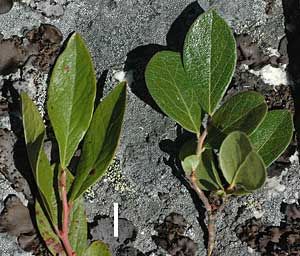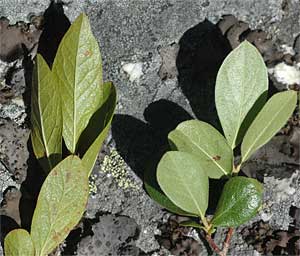Ericaceae: Gaylussacia bigeloviana (Fernald) Sorrie & Weakley
(bog huckleberry)
Synonym: Gaylussacia dumosa (Andrews) Torr. & A. Gray var. bigeloviana Fernald 1
Two species in the genus Gaylussacia (huckleberries) occur in Nova Scotia: G. baccata (black huckleberry) and G. bigeloviana (bog huckleberry). Both are are deciduous woody shrubs with five-parted flowers and a berry-like drupe containing 8 to 10 seed-like nutlets; leaves are simple, entire and resin-dotted. G. bigeloviana is a small shrub, 30 - 75 cm in height. Leaves are oval shaped, widest above the middle, thick (leathery), shiny on the upper surface and dotted with yellow to orange resinous glands; leaf margins are finely frilled and there is a distinct mucronate leaf tip. ("The midrib appears to extend beyond the tip of the leaf.")2. White to pink, bell shaped flowers borne on racemes appear in June and July in N.S. The fruit is covered with short hairs, and is black and sweet when mature. G. bigeloviana occurs in bogs and barrens near the coast of Nova Scotia. A coastal plain species, its range is eastern North America in states and provinces near the coast from Newfoundland south to Deleware, with disjunct ppulations in North Carolina and South Carolina.1 G. bigeloviana is secure in Nova Scotia and New Brunswick, vulnerable in P.E.I,, critically imperilled in Quebec; its status has not been assessed for Newfoundland and most states.
Sources | Notes & Refs | Selected Web Resources | Line Drawing
Click on images for larger versions.
| July 7, 2006. Halifax County: Polly's Cove barrens and bogs (near Peggy's Cove). Photographer: JackPine. | |

Habitat: Quaking mat by bog pond. |
 |

Habitat: Hummocky bog. |
 |

Habitat: Barrens. |

The young leaves at this time had a lot of red coloration, especially on the barrens. |
| Jul, 29, 2007. Halifax County: Polly's Cove barrens and bogs (near Peggy's Cove). Photographer: JackPine. | |

|

Bar is 1 cm. |

|

Bar is 1 cm. |
| Aug 19, 2005. Halifax County: Polly's Cove barrens & bogs. Photographer: JackPine. |

G. baccata (left) and G. bigeloviana (right), upper leaf surfaces. Bar is 1 cm. |

G. baccata (left) and G. bigeloviana (right), lower leaf surfaces. |

|
| Sep. 29, 2005. Halifax County: Polly's Cove barrens & bogs. Photographer: JackPine. | |

Leaf tips of V. angustifolium, G. baccata, G. bigeloviana. Units are 1 mm. G bigeloviana can be distinguished from G. baccata by its mucronate leaf tip and more leathery texture.
|
 Leaf margins of V. angustifolium, G. baccata, G. bigeloviana.. Gland tipped hairs can be seen in leaves of V. angustifolium and G. bigeloviana. Bar is 1 mm. |
| Oct 3-7 2006. Halifax County: Polly's Cove barrens & bogs. Photographer: JackPine. | |

Bar is 1 cm. Eight seeds were taken from a separate berry. |

|
 |
Selected Web Resources
- Taxonomic Status (ITIS) Copy the species name above and paste it into a form on this ITIS Canada page to confirm the nomenclature and list synonyms.
- NatureServe Explorer Copy the species name above and paste it into a form on this page to view a map of its distribution within North America and its conservation status by province and state.
- Fire Effects Information Service: Gaylussacia dumosa
Notes & References
- In Roland et al. (1998) this species is cited as Gaylussacia dumosa. Sorrie and Weakley (2007) present evidence that 4 species should be recognized within the Gaylussacia dumosa complex. G. bigeloviana alone is found from Deleware north; it is distinguished from other species by morphological features and habitat. See: Sorrie, B.A. & Weakley, A.S. 2007. Note on the Gaylussacia dumosa complex (Ericaceae). Journal of the Botanical Research Insitute of Texas 1 (1): 333-344. PDF available at http://www.brit.org/fileadmin/Publications/JBotResInstTexas_1_1_/23_Sorrie_Weakley_Gaylussacia_333-344.pdf. Thanks to Sue Meades for bringing this paper to our attention.
- Roland, A.E., Zinck, M. and Owen, E. 1998. Roland's Flora of Nova Scotia, 3rd Ed. Halifax: Nimbus & Nova Scotia Museum.